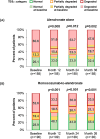Romosozumab improves microarchitecture as assessed by tissue thickness-adjusted trabecular bone score in postmenopausal women with osteoporosis
- PMID: 39656908
- PMCID: PMC11789382
- DOI: 10.1093/jbmr/zjae194
Romosozumab improves microarchitecture as assessed by tissue thickness-adjusted trabecular bone score in postmenopausal women with osteoporosis
Abstract
Bone mineral density (BMD) is only one of several bone strength determinants affected by osteoporosis therapies. Trabecular Bone Score (TBS), a gray-level texture index determined from lumbar spine (LS) dual-X-ray absorptiometry scans, is an indirect measure of bone microarchitecture independent of and complementary to BMD and clinical risk factors. In the Active-Controlled Fracture Study in Postmenopausal Women with Osteoporosis at High Risk (ARCH), monthly subcutaneous romosozumab 210 mg for 12 mo followed by 24-mo open-label weekly oral alendronate 70 mg (romosozumab-to-alendronate) significantly reduced fracture risk compared to 36-mo alendronate alone in postmenopausal women with osteoporosis and prior fracture. This analysis evaluated tissue thickness-adjusted TBS (TBSTT) in a subgroup of patients from ARCH who had post-hoc TBS measurements at baseline and at least one post-baseline visit at months 12, 24, and 36. Baseline characteristics were similar between romosozumab-to-alendronate (n = 190) and alendronate alone (n = 188). Romosozumab led to significantly greater gains in TBSTT vs alendronate at month 12 (least squares mean difference, 3.6%), with greater gains maintained after transition to alendronate and persisting at months 24 (2.9%) and 36 (2.3%; all p<.001). Romosozumab-to-alendronate increased the percentage of individual patients with "normal" TBSTT from 28.9% at baseline to 48.1%, 43.9%, and 45.4% at months 12, 24, and 36, respectively, and decreased the percentage of individual patients with degraded TBSTT from 52.6% to 33.3%, 36.0%, and 33.5%, respectively (all p<.001). A similar but smaller trend was observed with alendronate alone from baseline through month 36 (p ≤.012). Changes in TBSTT and LS BMD were largely unrelated from baseline to month 12 (romosozumab-to-alendronate, r2 = 0.065; alendronate alone, r2 = 0.021) and month 36 (r2 = 0.058; r2 = 0.057, respectively). In postmenopausal women with osteoporosis and prior fracture, 12-mo romosozumab followed by 24-mo alendronate significantly improved bone microarchitecture estimated by TBSTT more than 36-mo alendronate alone.
Keywords: DXA; anabolics; fracture prevention; menopause; osteoporosis.
Plain language summary
Osteoporosis is characterized by decreased bone mass and deteriorated microarchitecture. Bone mass is measured as bone mineral density (BMD) by dual-energy X-ray absorptiometry (DXA). Bone microarchitecture can be measured indirectly by Trabecular Bone Score (TBS). Romosozumab, a bone-building therapy for postmenopausal women with osteoporosis, has been shown to increase BMD and reduce fracture risk compared to alendronate in the Active-Controlled Fracture Study in Postmenopausal Women with Osteoporosis at High Risk (ARCH). This analysis evaluated TBS in a subgroup of patients from ARCH who had their existing DXA scans measured for TBS post study. An updated method with tissue thickness–adjusted TBS (TBSTT) was used to account for regional soft tissue thickness. We found over 12 mo, romosozumab increased TBSTT more than alendronate. The increase in TBSTT was maintained following transition to alendronate for 24 mo. Further, treatment with romosozumab-to-alendronate increased the proportion of patients with “normal” TBSTT and decreased the proportion with “degraded” TBSTT more than alendronate alone. Changes in TBSTT and BMD from baseline were largely unrelated, supporting that TBS and BMD are two independent predictors of fragility fracture. In postmenopausal women with osteoporosis, 12-mo romosozumab followed by 24-mo alendronate improved bone microstructure estimated by TBSTT more than 36-mo alendronate alone.
© The Author(s) 2024. Published by Oxford University Press on behalf of the American Society for Bone and Mineral Research.
Conflict of interest statement
Michael McClung received honorarium from Amgen and consulting fees from Alexion, Amgen, and Radius Health. Benjamin Z. Leder received research funding from Amgen and consulting fees from Radius Pharma. David L. Kendler received consulting fees from Amgen, Biosyent, and Paladin, honorarium from Amgen, and grants/research support from Radius Pharma. Jen Timoshanko is an employee and stockholder of UCB. Donald Betah is a previous employee and stockholder of Amgen. Mary Oates and Zhenxun Wang are employees and stockholders of Amgen.
Figures



Similar articles
-
Romosozumab Improves Tissue Thickness-Adjusted Trabecular Bone Score in Women With Osteoporosis and Diabetes.J Clin Endocrinol Metab. 2025 Jan 24:dgae862. doi: 10.1210/clinem/dgae862. Online ahead of print. J Clin Endocrinol Metab. 2025. PMID: 39854280
-
Updated trabecular bone score accounting for the soft tissue thickness (TBSTT) demonstrated significantly improved bone microstructure with denosumab in the FREEDOM TBS post hoc analysis.Osteoporos Int. 2022 Dec;33(12):2517-2525. doi: 10.1007/s00198-022-06549-x. Epub 2022 Sep 17. Osteoporos Int. 2022. PMID: 36115888 Free PMC article.
-
3D-modeling from hip DXA shows improved bone structure with romosozumab followed by denosumab or alendronate.J Bone Miner Res. 2024 May 2;39(4):473-483. doi: 10.1093/jbmr/zjae028. J Bone Miner Res. 2024. PMID: 38477808 Free PMC article. Clinical Trial.
-
Use of Trabecular Bone Score (TBS) as a Complementary Approach to Dual-energy X-ray Absorptiometry (DXA) for Fracture Risk Assessment in Clinical Practice.J Clin Densitom. 2017 Jul-Sep;20(3):334-345. doi: 10.1016/j.jocd.2017.06.019. Epub 2017 Jul 19. J Clin Densitom. 2017. PMID: 28734710 Review.
-
Romosozumab: A Review in Postmenopausal Osteoporosis.Drugs Aging. 2020 Nov;37(11):845-855. doi: 10.1007/s40266-020-00793-8. Drugs Aging. 2020. PMID: 32909197 Review.
Cited by
-
Bone Health, Fragility Fractures, and the Hand Surgeon.J Hand Surg Glob Online. 2025 Mar 12;7(3):100709. doi: 10.1016/j.jhsg.2025.02.002. eCollection 2025 May. J Hand Surg Glob Online. 2025. PMID: 40496405 Free PMC article. Review.
References
-
- Bauer JS, Kohlmann S, Eckstein F, Mueller D, Lochmüller EM, Link TM. Structural analysis of trabecular bone of the proximal femur using multislice computed tomography: a comparison with dual X-ray absorptiometry for predicting biomechanical strength in vitro. Calcif Tissue Int. 2006;78(2):78–89. 10.1007/s00223-005-0070-3 - DOI - PubMed
-
- Black DM, Bauer DC, Vittinghoff E, et al. Treatment-related changes in bone mineral density as a surrogate biomarker for fracture risk reduction: meta-regression analyses of individual patient data from multiple randomised controlled trials. Lancet Diabetes Endocrinol. 2020;8(8):672–682. 10.1016/S2213-8587(20)30159-5 - DOI - PubMed
Publication types
MeSH terms
Substances
Grants and funding
LinkOut - more resources
Full Text Sources
Medical

